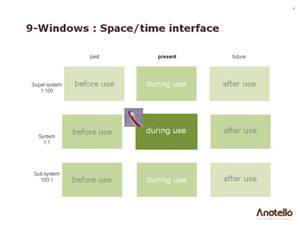Anatellô
Monthly Archive
How Heston Blumenthal Can Help Us With TRIZ.

Heston Blumenthal, the consummate food innovator has now decided to innovate his dining offer beyond the food. He wants to extend the pleasure for the diners who make a reservation at his restaurant so that the overall experience lasts longer and is more satisfying...
Now, when diners make a reservation they will be sent a video to watch in advance of their visit to his Michelin starred Fat Duck restaurant. The video is intended to whet both the imagination and the appetite of the future clientele, with stories and images about his restaurant. His ambition is to make them to feel like they are ‘a child in a sweet shop’.
A Gentle Introduction to TRIZ.
Heston's innovation is an example that can help us with an aspect of TRIZ methodology. TRIZ is an incredibly powerful philosophy and toolkit for innovators. The trouble is, people are sometimes put off using it because they think it is complex and that they have to be familiar with the whole body of knowledge before they can make use of even a part of it. Not so. TRIZ offers tools and techniques that can easily be integrated into a broad range of innovation processes and approaches. None more so than the ‘9-Windows technique’. Perhaps Heston used this when he was innovating his restaurant offer!
The 9-Windows tool can be applied quite simply as we outline below, and also in combination with other innovation methodologies to become a more complex problem defining tool.
Innovation Opportunities in Time and Space.
Typically, when we are faced with a problem solving challenge – say when asked how to design a better toothbrush, our brains naturally cause us to focus on the system – the toothbrush in the act of toothbrushing. This is a focus on the here and now.
The 9-Windows model can trick our brains into thinking differently, and helps us to focus on the bigger picture – the supersystem and the things that surround us; the toothpaste, the bathroom shelf, the sink, the house and the subsystem, the toothbrush bristles, the water droplets on the brush, the fibres of the brush etc.
With regard to time, instead of just thinking about brushing in the present, the 9-Windows tool encourages us to think about what happens before we brush and what happens after we brush.
By reviewing the wider system and the bigger time dimension, we can potentially find more opportunities to innovate the toothbrush or ‘toothbrushing event’.
The important thing to remember is that you as the innovator set the scales. So the time scale might be two minutes before and after use for some products, it might be two days, two weeks, two months or two years. Fundamentally what 9-Windows is doing is reminding you that the toothbrush does not exist in isolation. It exists in a space/ time continuum and by tapping into that continuum at various points, you may find new opportunities to innovate.
So, back to Heston Blumenthal and his innovating. With regard to time, it would have been easy for him to just focus on the dining experience ‘on the night’, but he has identified that an important part of the customer experience that could be developed is the anticipation in advance of visit to his restaurant. With regard to the system the starting point would typically be the restaurant; the food and the service. However, In this new innovation he is improving the offer to people’s imaginations – arguably part of the supersystem.
The 9-Windows tool can be combined with other innovation and planning tools like SWOT analysis, and Representational Systems from NLP ; visual, auditory, kinesthetic etc, to direct our brains into additional areas for potential innovation .
If you’re not familiar with 9-Windows, we suggest you start simply and use it as a piece of stimulus for idea generation. Let it trick your brain inot wandering into some less familiar innovation territory…
Read more about Heston Blumenthal’s service innovation.
© 2012 AnatellÔ Ltd. All rights reserved.



